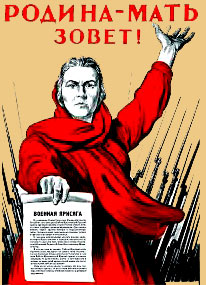 With
the outbreak of the Second World War, the Soviet Union found
itself unprepared for the conflict. With
the outbreak of the Second World War, the Soviet Union found
itself unprepared for the conflict.
Political purges had stripped the military of much of
its experienced leadership, and industrial production was slow
in converting from civil to military production.
Although its non-aggression pact with Germany (1939)
served for a while to forestall an attack by Hitler, the Soviets
were caught by surprise by the invasion of June 1941.
The greatest land war in recorded history began at 3.30
a.m. on 22 June 1941, the day after the 129th anniversary of
Napoleon's attack on Russia in 1842.
|
 |
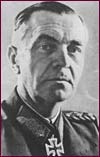 The
initial German front was 995 miles-1600 km long. The main front
would soon expand to 1490 miles-2384 km and extend to a depth
of over 600 miles-960 km. In to this great space of steppe,
forest and swamp marched the best of the German Army, amounting
to The
initial German front was 995 miles-1600 km long. The main front
would soon expand to 1490 miles-2384 km and extend to a depth
of over 600 miles-960 km. In to this great space of steppe,
forest and swamp marched the best of the German Army, amounting
to
threequarters of it's field strength.
By the end of the year, the Germans had seized most of
the Soviet territory in the west, surrounded St.
Petersburg (having been renamed once again as Leningrad),
and advanced to within a few hundred miles of Moscow.
About 3.500.000 Red Army soldiers were in captivity and 4.000.000
had died in battle. At one time the Germans occupied some 900.000
square miles-1.440.000 square km of Soviet territory.
|
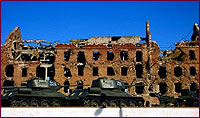 With
tremendous effort, a Russian counter-offensive pushed back the
advance on the capital, but in the summer of 1942 the Germans
launched a new invasion against the southern front in an attempt
to gain control of the rail center of Stalingrad on the Volga
and the vital Caucasus oil fields. With
tremendous effort, a Russian counter-offensive pushed back the
advance on the capital, but in the summer of 1942 the Germans
launched a new invasion against the southern front in an attempt
to gain control of the rail center of Stalingrad on the Volga
and the vital Caucasus oil fields.
|
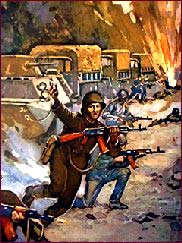 The
German Sixth Army was ordered to take Stalingrad - 'smash
the enemy forces concentrated there, occupy the town and block
land communications between the Don and the Volga'.
Stalingrad was a long urban strip strung out along the west
bank of the Volga. Hitler was determined to capture it as it
was a major manufacturing centre and the key to the communications
system of southern Russia. The
German Sixth Army was ordered to take Stalingrad - 'smash
the enemy forces concentrated there, occupy the town and block
land communications between the Don and the Volga'.
Stalingrad was a long urban strip strung out along the west
bank of the Volga. Hitler was determined to capture it as it
was a major manufacturing centre and the key to the communications
system of southern Russia.
In German hands it would block Russian attempts to destroy
German armies between the Don and Caucasus. But Stalin was equally
determined to defend it, not least as it bore his name. His
order was read out to every Soviet soldier -
'Not a step backwards!' Hence the clash of the titans.
|
 The
Battle of Stalingrad (August 1942 - February 1943) was the decisive
Soviet victory that stopped the German southern advance and
turned the tide of the war. At Stalingrad Soviet armies began
the series of offensives that were to take them to Berlin. The
Battle of Stalingrad (August 1942 - February 1943) was the decisive
Soviet victory that stopped the German southern advance and
turned the tide of the war. At Stalingrad Soviet armies began
the series of offensives that were to take them to Berlin.
From August 23, when German Sixth Army forces, commanded
by General Friedrich Paulus, reached the Volga at Stalingrad,
Soviet and German infantry fought a long, house-to-house battle
for the city. The occupying Russian army was fanatical. It contested
every street and factory, whether still standing or totally
destroyed. Territory which the Germans, with their superior
fire power, had won by day was regained by night. At the end
city was completely leveled. There were no tall buildings left
in Stalingrad.
|
|
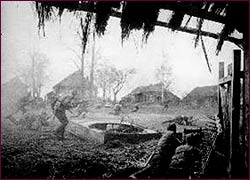 At
the same time Soviet armies, ultimately numbering an estimated
1 million men, built up. On 19 November, preceded by an enormous
barrage, forces under General Zhukov attacked on both German
flanks. Within 5 days they had executed a pincer movement
that encircled 250,000-300,000 German and satellite troops
- the besiegers were besieged. Hitler forbade Paulus from
attempting to break out to the rear, which he might have done
early in the encirclement. At
the same time Soviet armies, ultimately numbering an estimated
1 million men, built up. On 19 November, preceded by an enormous
barrage, forces under General Zhukov attacked on both German
flanks. Within 5 days they had executed a pincer movement
that encircled 250,000-300,000 German and satellite troops
- the besiegers were besieged. Hitler forbade Paulus from
attempting to break out to the rear, which he might have done
early in the encirclement.
|
|
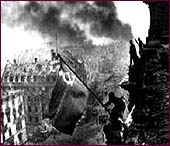 Goering
promised him an airlift which never materialised. A relief
army stalled in December and rations had to be reduced. Ammunition
was running low. In January the Russians called on von Paulus
to surrender. Hitler ordered him to refuse, made him a Field
Marshal and informed him that no German Field Marshal had
ever been taken alive. Goering
promised him an airlift which never materialised. A relief
army stalled in December and rations had to be reduced. Ammunition
was running low. In January the Russians called on von Paulus
to surrender. Hitler ordered him to refuse, made him a Field
Marshal and informed him that no German Field Marshal had
ever been taken alive.
|
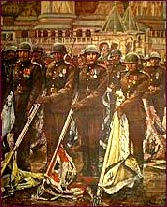 The
German position was now hopeless. Troops slowly froze, starved
and ran out of ammunition. Paulus's forces were divided into
two parts by a Russian thrust. By January 30th he was trapped
in the basement of the large department store in Stalingrad
where he had set up his final HQ. To Hitler's disappointment
he preferred to surrender and live: on 2 February he and his
staff gave themselves up. By then 70,000 Germans had died in
Stalingrad. The Russians took 91,000 prisoners, including twenty-four
German generals. Only 6000 ever returned. Hitler himself said,
'The god of war has gone over to the
other side'. The
German position was now hopeless. Troops slowly froze, starved
and ran out of ammunition. Paulus's forces were divided into
two parts by a Russian thrust. By January 30th he was trapped
in the basement of the large department store in Stalingrad
where he had set up his final HQ. To Hitler's disappointment
he preferred to surrender and live: on 2 February he and his
staff gave themselves up. By then 70,000 Germans had died in
Stalingrad. The Russians took 91,000 prisoners, including twenty-four
German generals. Only 6000 ever returned. Hitler himself said,
'The god of war has gone over to the
other side'.
|
 Despite
an overwhelming disadvantage in numbers and inferior weaponry,
the Russian army succeeded in holding out against the enormous
German army. In November, a relieving force managed to encircle
the attackers and compel the surrender of the entire force,
marking a decisive turning point in the war. From that point
onward, the Russian army remained on the attack. By 1944 they
had driven the Germans back to Poland, and on May 2, 1945, Berlin
fell. Despite
an overwhelming disadvantage in numbers and inferior weaponry,
the Russian army succeeded in holding out against the enormous
German army. In November, a relieving force managed to encircle
the attackers and compel the surrender of the entire force,
marking a decisive turning point in the war. From that point
onward, the Russian army remained on the attack. By 1944 they
had driven the Germans back to Poland, and on May 2, 1945, Berlin
fell.
As was the case with the Napoleonic Wars, the Soviet Union
emerged from World War II considerably stronger than it had
been before the war. Although the country suffered enormous
devastation and lost more than twenty million lives,
it had gained considerable territory and now ranked as one of
the two great world powers along with the United States.

|
|
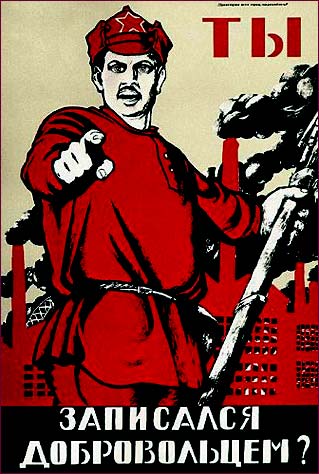
Soviet War Poster: "Have
you volunteered?" |

|
Siege of Leningrad
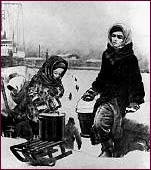 This
was certainly the most tragic period in the history of this
city. It was full of suffering and heroism. For everyone who
lives in St. Petersburg the Blokada
(the Siege) of Leningrad is an important part of their heritage
and for the older generations it brings the memories that they
will never forget. This
was certainly the most tragic period in the history of this
city. It was full of suffering and heroism. For everyone who
lives in St. Petersburg the Blokada
(the Siege) of Leningrad is an important part of their heritage
and for the older generations it brings the memories that they
will never forget.
The German army advanced so rapidly toward Leningrad
that less than two and a half months after June 22, 1941,
when the Soviet Union was attacked by Nazi Germany, German
troops were already approaching Leningrad. The Red Army was
outflanked and on September 8, 1941 the Germans had fully
encircled Leningrad and the siege began.
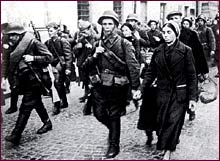 Leningrad
was a particularly cosmopolitan city in which the arts flourished,
despited Soviet rule. It had a long and glorious history which
went back to the Tsars, when it was called, St. Petersberg,
but after the October Revolution
it was renamed Leningrad, after Lenin,
one of the founders of the communist movement. Leningrad
was a particularly cosmopolitan city in which the arts flourished,
despited Soviet rule. It had a long and glorious history which
went back to the Tsars, when it was called, St. Petersberg,
but after the October Revolution
it was renamed Leningrad, after Lenin,
one of the founders of the communist movement.
Siege lasted for about 900 days, from September 8,
1941 till January 27, 1944. The city (whose population then
totaled nearly three million people) was completely cut off
from the rest of the country, and it was Hitler’s intention
to literally starve the city into submission.
Food and fuel stocks were very limited (1-2 months
only). All the public transport stopped. By the winter
of 1941-42 there was no heating, no water supply, almost no
electricity and very little food. In January 1942, in
the depths of an unusually cold winter, the lowest food rations
in the city were only 125 grams (about 1/4 of a pound) of
bread per day. In just two months, January and February,
1942, 200 thousand people died in Leningrad of cold and starvation.
But some of the war industry still worked and the city did
not surrender.
Harrison Salisbury, in his book 900 Days: The Siege
of Leningrad, wrote, “This was
the greatest and longest siege ever endured by a modern city,
a time of trial, suffering and heroism that reached the peaks
of tragedy and bravery almost beyond our power to comprehend...Hitler’s
attempt to wipe Leningrad off the map resulted in an almost
unequaled example of courage, strength and determination from
the city’s populace.”
Meanwhile, the city lived on. The treasures of the
Hermitage and the suburban palaces of Petrodvorets,
Pushkin, etc. were hidden in the basements of the Hermitage
and St Isaac's Cathedral. Most students continued their studies
and even passed finals.
In the midst of this misery, Dmitri Shostakovich was
composing the Seventh "Leningrad" Symphony, a work
of music that bore the stamp of genius, from a man who himself
had suffered Stalin’s scorn.
When he finally finished the symphony, there were
only 16 members still alive of the Leningrad Symphony Orchestra,
which had previously numbered over 100. And the symphony was
scored for a large orchestra. Signs were put up all over Leningrad,
asking any musicians who were still alive and could play an
instrument, and could get to the symphony hall to assemble.
Word got around and musicians came from all over the city
and from combat units, and assembled to rehearse this Seventh
Symphony. For an entire week this ragged group of tired, sick,
emanciated but incredibly dedicated musicians rehearsed the
symphony.
On the day of the performance, the commander-in-chief
of the city’s armed forces ordered his heavy artillery
to knock out as many German guns as possible so that there
would be no interruptions in the performance. As the bombardment
subsided the first note of the symphony sounded. The performance
was not only the most emotion-laden presentation of the work
imaginable, but was surely one of the most electrifying concerts
ever given. Whatever the technical shortcomings the performance
might have had counted for nothing; the impact on the audience
was truly extraordinary.
In January 1943 the Siege was broken and a year later,
on January 27, 1944 it was fully lifted. At least 641 thousand
people had died in Leningrad during the Siege (some estimates
put this figure at 800 thousand). Leningrad still remains
a symbol of Nazi brutality and aggression on the Eastern Front.
 Elena
Taranukhina lived through the siege of Leningrad and is sharing
her experience now. (Eng.) Elena
Taranukhina lived through the siege of Leningrad and is sharing
her experience now. (Eng.)
|
|



